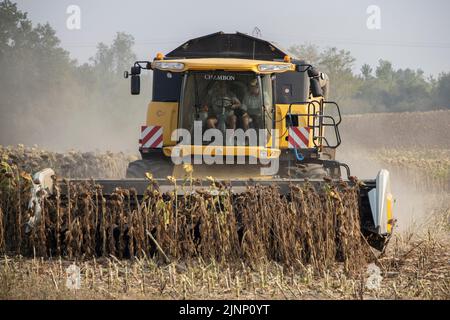


While this region is popular with tourists, most stay on the land. The name alone evokes a romantic notion of French rustic charm with grand castles and lush nature. I’m on the Dordogne River in the south of France – a waterway of about 500 kilometres that reaches the sea near Bordeaux. But, then again, it’s not that often that I have the opportunity to kayak with scenery like this. There’s plenty of space so you always escape the other Brits if you want to.At times I wonder if I’m doing more floating than paddling. Property (like the wine) is relatively cheap and plentiful. Transport links are good, with airports at Bergerac and Bordeaux, and the train from London via Paris or Lille terminates at Libourne. Charlotte and Tom have been living in France for about ten years and run their own gardening business: “We started out with a single recommendation from friend-of-a-friend and now we look after about 20 different gardens, all of them for second-homers.” Their daughter is one of 20 English pupils at the local school. It’s been estimated that there are around 800 British-owned businesses around the bastide town of Eymet, although a lot of these are servicing the expat community. The Dordogne used to be popular almost exclusively with retired couples. Helen (who is fluent) and Sam (who is ‘improving’) quickly made good friends with other expats in the area and their French neighbours: “We have sons the same age, and with no fences or walls between our properties, the kids run between the houses.” But it’s been harder to make other French friends: “People are warm, you bump into them on market day and in the local cafes but it can be hard to make the step from acquaintance to friend.” The downside to this is that you can end up not being fully integrated into the local community. With so many Brits in the Dordogne, it’s a relatively easy area to move to if your French is limited. By the end of the first year, we had to repaint all of the exterior walls a freezing winter damaged the mosaics in the pool and we had bees’ nests in the roof!” They converted an old chai (wine store) into a gîte to provide an income during the hot summer months, besides renting it out to a writer for six months every winter. “We painted the house in hot sunny colours and put up new curtains and it looked amazing,” says Helen, “but we definitely underestimated the amount of maintenance required. The English couple they bought it from had spent a lot of time and money on renovations, including converting a roofless barn into a walled swimming pool, and they were able to buy some of the existing furniture. We couldn’t believe how much we could get for our money.” “It was the archetypal French farmhouse: blue wooden shutters, vine over the door, with several dependences and a huge garden and meadow. Helen and Sam bought an old stone house about five years ago, with outbuildings in a hamlet – just a single lane with about eight houses dotted along it – not far from Bergerac. Whatever the reason, expats have come in droves to live and work here. Maybe it’s the perfect climate, the gorgeous medieval villages, the lush green rolling hills, the house prices (much lower than the UK), the meandering flowing Dordogne or the freely flowing wine. The Dordogne, in the southwest region of Aquitaine, has been attracting expats since the 1960s – not just vast numbers of les Anglais (hence the ‘Dordogneshire’ joke) but with Dutch and Germans too. A guide to living in the luscious countryside of the Dordogne and one of the most popular expat areas of France.


 0 kommentar(er)
0 kommentar(er)
